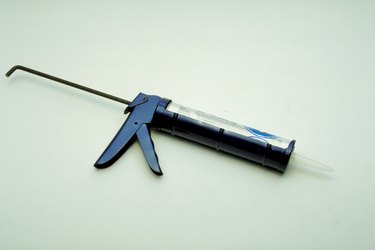Things You'll Need
Human model
Plaster of Paris
Petroleum jelly
Small coin
Duct tape
Latex caulk
Caulk gun
Skin-tone latex paint
Plain gelatin or ballistic gelatin powder
Double boiler
Candy thermometer

Sculptors and special effects artists use two-part molds to create replicas of human body parts. A plaster mold creates a negative impression of an object from which multiple positives can be cast. Forensic scientists use ballistic gel to simulate human flesh for applications like the study of gunshot wounds. You can make a mold of a body part and mix up some DIY ballistic gel for very little money.
Making a Mold
Step 1
Find a box that is long enough to accommodate the body part you want to replicate. For this example, we will cast a model of an arm and hand. Cut a U-shape down one side of the box, ending a few inches from the bottom. The U should be slightly wider than the forearm.
Video of the Day
Step 2
Coat the model's arm and hand with a layer of petroleum jelly.
Step 3
Mix a bucket of plaster of Paris according to package directions.
Step 4
Pour the plaster into the box up to the bottom of the U-shaped cut.
Step 5
Have the model lay his arm palm-down in the plaster. Allow the plaster to set for 10 to 15 minutes. It will become very warm as it sets.
Step 6
Scoop out divets in the four corners of the plaster inside the box with a small coin as the plaster is setting. You are creating registration points that will help the two halves of the mold align.
Step 7
Remove the model's hand when the bottom half of the mold is set. Apply petroleum jelly to the bottom half of the mold.
Step 8
Replace the model's hand in the mold. Pour another 3 inches of plaster of Paris over the hand and allow to set.
Step 9
Gently lift the two halves of the mold apart and have the model remove his hand.
Casting the Gel
Step 1
Mix one pound of gelatin powder to one gallon of tap water. Stir well and allow to set in the refrigerator for two hours.
Step 2
Heat the cooled gelatin with a double boiler. Test with a candy thermometer while heating to make sure the gelatin does not reach a temperature greater than 130 degrees F.
Step 3
Apply more petroleum jelly or silicone release spray to the contours of the hand inside your mold.
Step 4
Insert the latex caulk into the caulk gun and squirt a line around the perimeter of the hand. Replace the top half of the mold. Make sure the registration points align and the caulk forms a seal. Set the mold on end so that the fingers point down. Duct tape around the mold several times to fully seal it.
Step 5
Pour in the ballistic gel and allow to set.
Remove and Paint the Body Part
Step 1
Carefully separate the two parts of the mold when you can poke the gelatin at the top of the mold and feel resistance. Lift out the arm and hand and let it chill in the refrigerator until solid.
Step 2
Remove the cooled hand from the refrigerator in two hours.
Step 3
Gently wipe away any condensation and paint the hand with flesh-toned latex paint for a realistic look.
Tip
Use a wire armature inside the body part you cast to provide more structure.
Video of the Day